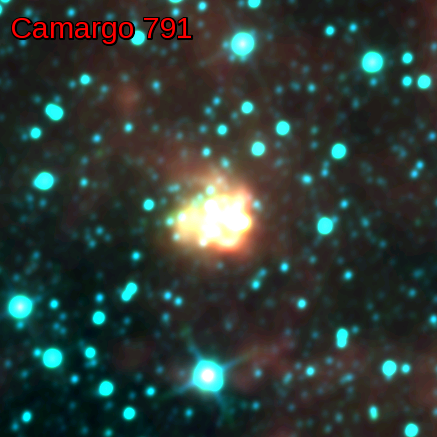November 16, 2015 report
Peering into building blocks of galaxies

(Phys.org)—When a giant cloud of molecular gas condenses, star clusters are born. It may sound simple but the formation of star clusters is a very complex process, not yet completely understood by scientists. By peering into this process we could get valuable information on the evolution of galaxies and improve our knowledge about large cosmic structures in the universe.
"Star clusters are often considered as building blocks of galaxies. Understanding how these objects form and evolve is vital to our comprehension of the structure, formation and evolution of galaxies," Denilso Camargo of the Federal University of Rio Grande do Sul and Colégio Militar de Porto Alegre, Brazil, told Phys.org.
Camargo and his colleagues Eduardo Bica and Charles Bonatto, also from the Federal University of Rio Grande do Sul, have recently discovered a multitude of star clusters using NASA's Wide-field Infrared Survey Explorer. In a paper published online on Nov. 9 on ArXiv, they announced the finding of 652 star clusters, stellar groups and candidates in the Milky Way galaxy.
The researchers targeted 862 objects for observations by WISE. They were looking for dust emission nebulae followed by a search for stellar overdensities within them. What they found is a variety of interesting objects classified as open clusters (OCs), open cluster candidates (OCCs), embedded clusters (ECs), embedded cluster candidates (ECCs), and embedded stellar groups (EGrs).
There are two main groups of star clusters: OCs and globular clusters (GCs). OCs are generally young objects, up to a few tens of millions of years old. They are much less densely populated and much less tightly gravitationally bound than GCs. In contrast to OCs, globular clusters are tight groups of very old stars, distributed roughly spherically in the galactic halo, around the galactic center. They have highly elliptical orbits around the galactic center, while OCs are usually located in the galactic plane, almost always within spiral arms.
ECs are also intriguing and peculiar stellar clusters. They are partially or fully encased in interstellar dust or gas. They consist of extremely young, recently formed or forming stars. For scientists, they are important laboratories for the study of star formation and early stellar evolution.
Camargo noted that the diversity of star clusters comes in handy when dealing with questions still baffling astronomers.
"The open cluster system has been used to analyze the structure, dynamics, composition and evolution of the Milky Way's disk. Old open clusters are excellent probes of disk formation and early evolution. Young open clusters have been used as tracers of the spiral pattern in galactic disks," Camargo said.
He added that his team recently used embedded clusters to trace the spiral structure of our Galaxy. The results favor a four-armed spiral pattern for the Milky Way.
Studying star clusters is a fundamental task for researchers when it comes to unlock the secrets of star formation process, as most stars, if not all, form in star clusters. Moreover, the chemical evolution of the universe is directly related to stellar evolution in the sense that metals currently observed are synthesized in the interior of the stars, which are born within star clusters.
The research team led by Camargo has a stunning record of 1098 star clusters found so far. The newest list is a follow-up of the 446 previous discoveries detailed in three other papers.
More information: Characterizing star cluster formation with WISE: 652 newly found star clusters and candidates, arXiv:1511.01978 [astro-ph.GA] arxiv.org/abs/1511.01978
Abstract
We report the discovery of 652 star clusters, stellar groups and candidates in the Milky Way with WISE. Most of the objects are projected close to Galactic Plane and are embedded clusters. The present sample complements a similar study (Paper I) which provided 437 star clusters and alike. We find evidence that star formation processes span a wide range of sizes, from populous dense clusters to small compact embedded ones, sparse stellar groups or in relative isolation. The present list indicates multiple stellar generations during the embedded phase, with giant molecular clouds collapsing into several clumps composing an embedded cluster aggregate. We investigate the field star decontaminated Colour Magnitude Diagrams and Radial Density Profiles of 9 cluster candidates in the list, and derive their parameters, confirming them as embedded clusters.
Journal information: arXiv
© 2015 Phys.org



















